Walnut Trees Identification Guide (With Pictures): Leaves, Bark, Types
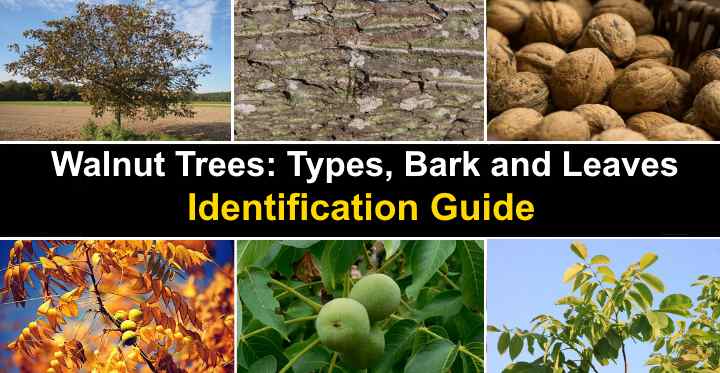
Are you interested in identifying walnut trees? This comprehensive guide will help you uncover the key features for accurate walnut tree identification. From their unique leaves and bark to variations in size and fruit characteristics, you’ll gain the knowledge needed to confidently recognize different walnut species.
Walnut trees are large deciduous trees with a rounded canopy of green, lush foliage. Most walnut trees have dark, ridged bark, pinnate feather-like leaves, and globular drupes that contain a nut. Walnut trees grow to between 33 and 131 ft. (10 – 40 m) tall, with a massive spread up to 50 ft. (15 m). Walnut trees are in the plant genus Juglans, and they are famous for their delicious nuts and beautiful wood.
Walnut Tree Facts
There are 21 species of walnut trees in the Juglandaceae family. The two most common varieties of walnut trees are the black walnut and the English walnut. In addition to these, there are other walnut tree varieties such as butternut, California black walnut, Andean walnut, Japanese walnut, and little walnut.
Varieties of walnut trees are native to Europe, North America, Asia, and China.
Most people associate walnut trees with the delicious nuts they produce. Botanically speaking, the walnut tree’s fruit is actually not a nut but a drupe. The nut is actually the seed of the walnut tree’s fruit. The walnut’s fruit has an outer fleshy green husk surrounding a hard shell that contains the seed (which we call walnut). A whole walnut resembles the appearance of a brain.
Walnut timber is a prized type of hardwood for making furniture. The wood of walnut trees is a dark brown, almost chocolatey color. The texture, beautiful grain, and walnut wood color make it ideal for carving bowls, making cabinets, or using it as a veneer.
Walnut Tree Varieties
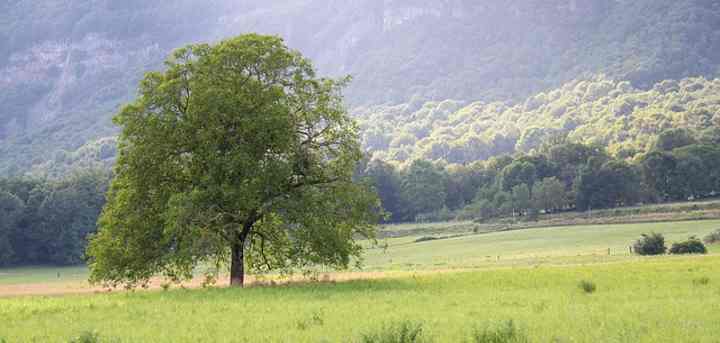
Walnut trees are large deciduous trees in the genus Juglans and include 21 species in the family Juglandaceae
The three most common walnut tree varieties are:
- Black walnut (Juglans nigra): Black walnut trees are characterized by their dark-colored bark with deep furrows, giving the trunk a rough texture. The nuts of black walnuts grow in rounded green husks, and the tree’s foliage consists of pinnate leaves.
- Butternut (Juglans cinerea) or White Walnut Trees: Butternut trees have a light gray bark with a smoother feel than black walnuts. As with all species of walnut, butternut tree leaves are pinnate, with up to 17 leaflets. The drupes are oval, rather than rounded shape.
- English walnut (Juglans regia): English walnut trees have olive-brown, smooth bark when young that gradually develops wide fissures. Like all species of walnut, the leaves are pinnate, but English walnut leaves are smaller. The whole fruit of English walnut trees is edible and has a rich flavor.
Walnut Tree Bark
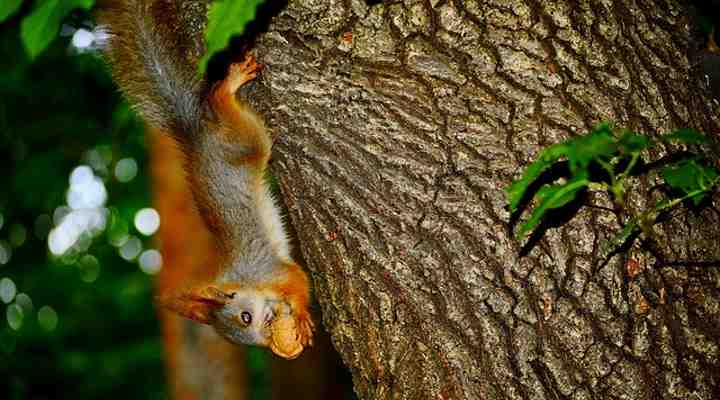
Walnut tree bark is usually rough with deep fissures
The bark of walnut trees is generally rough with deep fissures. The ridges run vertically up and down the trunk. Depending on the species, walnut bark can be light gray to dark brown. Removing the bark from English walnut or black walnut trees reveals a dark brown wood.
The bark helps differentiate between the species of walnut trees. Butternut (white walnut) bark is whitish-gray and smooth to the touch. English walnut and black walnut bark have deep vertical crevices and are a darker color.
Walnut Tree Leaves
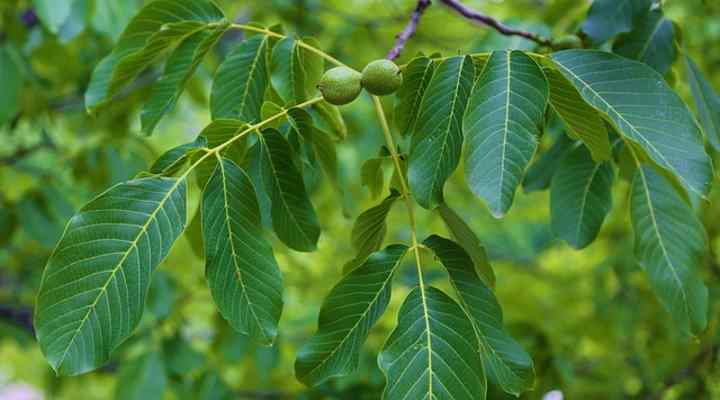
Walnut trees have pinnate leaves that turn yellow or brown in autumn
All 21 species of walnut trees boast feather-like pinnate leaves. Typically, each leaf blade carries two to nine pairs of leaflets, with an additional leaflet at the tip. As autumn arrives, these leaves transition into beautiful shades of yellow or brown. When crushed, walnut leaves emit a distinctive spicy citrus fragrance.
When comparing the three commonly found walnut tree species, the butternut (white walnut) tree stands out with its oblong-lanceolate leaves. On the other hand, English and black walnut trees have shorter and more rounded leaflets.
What sets black walnut apart from other species is the presence of a small terminal leaflet, which may sometimes be absent. However, both butternut and English walnut trees consistently feature a large leaflet at the tip.
Walnut Tree Nuts
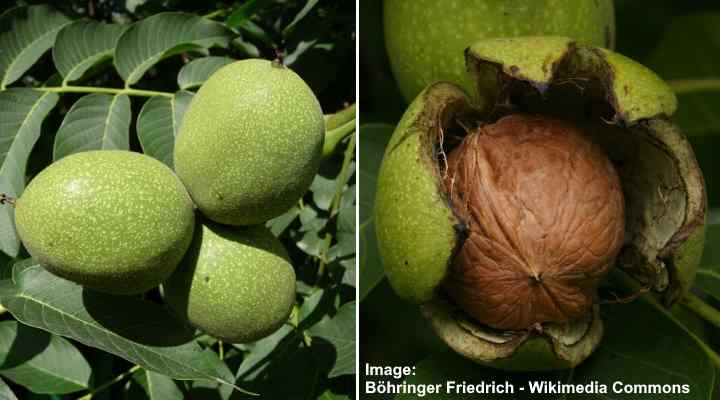
Immature walnuts look like green tennis balls on the tree (left image). On the right image is the walnut shell inside its green husk
Walnut trees can be easily identified by their distinctive nuts, also known as drupes. These fruits appear as small green balls growing on walnut trees. Each fruit consists of an outer green layer that encloses the nutshell and the kernel or nut. The nuts of walnut trees have two halves with a bumpy texture, covered by a papery outer layer.
Walnut Tree Identification
To identify walnut trees, search for distinctive characteristics including pinnate leaves with serrated leaflets, bark ranging from light gray to dark brown with prominent ridges, a sizable stature with a rounded canopy, and the existence of round or oval drupes that hold edible kernels. Walnut trees are known for their delicious nuts and are recognized for their distinct leaf structure and bark appearance.
Walnut tree bark typically features prominent vertical ridges along the trunk. The color of walnut bark can range from light gray to dark brown, often exhibiting diamond-shaped patterns. Certain walnut tree variations may display smoother and lighter bark.
The leaves of walnut trees are pinnate, consisting of pairs of leaflets. Additionally, most walnut leaves have a single leaf at the end of the twig. The largest leaflets are located at the center, and the leaves typically have between 5 and 25 leaflets. During the fall season, all walnut tree foliage undergoes a transformation, turning brown or yellow.
The walnut tree nuts resemble small round or oval green balls. These nuts or seeds are enclosed within a hard-brown shell. The taste of walnuts ranges from earthy to mild and sweet.
Types of Walnut Trees (With Pictures): Identification Guide
The most common walnut trees are the black walnut, English walnut, and butternut or white walnut. However, other varieties of walnut are found in South America, Asia, and southeastern Europe. It’s the black walnut and English walnut that are famous for their timber. English walnut nuts are the sweetest.
Here is information about the identifying features of the most popular types of walnut trees.
Black Walnut (Juglans nigra)
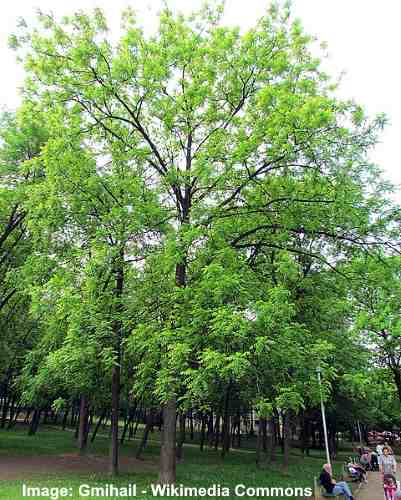
Black walnut (Juglans nigra) tree
The black walnut tree has dark, deeply fissured bark and grows to between 75 and 130 ft. (22 – 40 m) tall. The deciduous walnut tree is native throughout North America’s eastern part in USDA zones 4 – 9. Black walnut trees have medium growth, and they prefer to grow in sunny areas.
Black walnuts are also called the eastern American black walnut or American walnut. Their native habitat is from southern Ontario to northern Florida and they grow in forests and woodlands. These walnut trees can live up to 130 years.
The black walnut tree has a large, rounded crown of large pinnate leaves. The spread of the sizeable nut-bearing tree can be as wide as it is tall.
Black walnut tree leaves and stems have a pungent citrus-like odor.
The male and female species of black walnut trees produce flowers. The male walnuts have long catkins that hang from the branches. The female walnut produces small clusters of flowers on the end of short spikes.
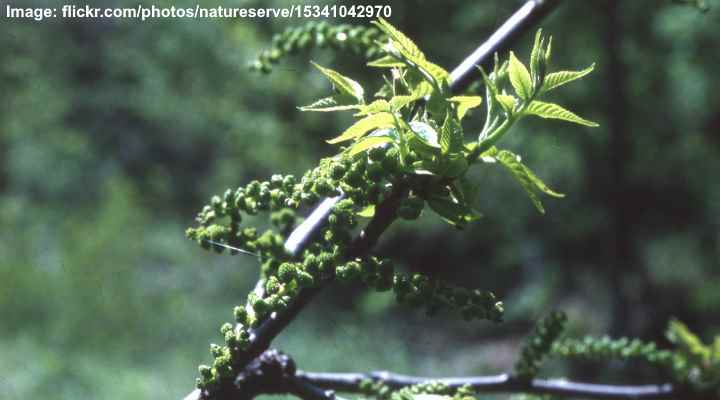
New leaves and catkins (flowers) of black walnut
After flowering, the black walnut tree produces globe-shaped green fruits that look like green balls – they are are 2” (5 cm) in diameter.
When the black walnuts have just fallen from the tree they look like rough green balls. As they mature on the ground, their husk turn from green to very dark brown (or even black). Inside the tough husk is the hard shell protecting the edible nut.
Another distinguishing characteristic of black walnut trees is the release of toxic chemicals into the soil, which inhibit plant growth within a radius of 50 to 80 feet (15 – 24 m) around the tree.
Walnut tree bark: The black walnut tree has dark gray to brown bark with deep ridges in diamond shapes. The distinctive bark pattern makes it easy to identify black walnut trees in the winter.
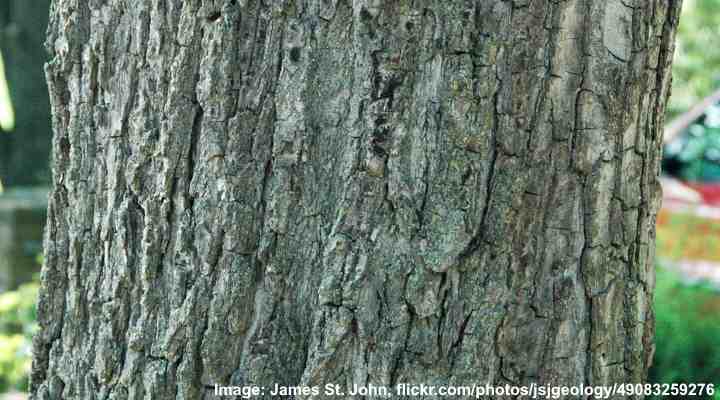
Black walnut bark
Walnut tree leaves: Black walnut leaves are pinnately compound with 15 to 23 leaflets on each twig. Leaflets are 3” to 4” (7 – 10 cm) long. The leaves have a slightly serrated edge and are an ovate, lanceolate shape. Leaves turn yellow in the fall.
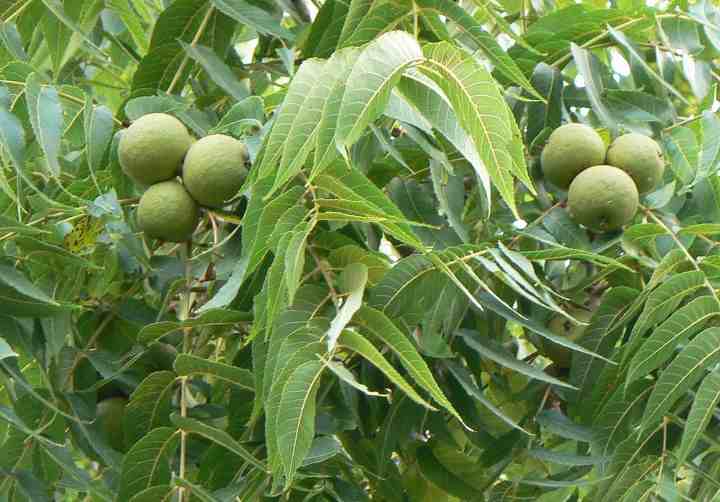
Black walnuts look like green balls on the tree – they have similar color to the green tree leaves.
How to Identify the Walnut Tree
The black walnut tree (Juglans nigra) can be identified by its compound leaves with 15 to 23 elongated leaflets, dark gray to brown bark with deep furrows, and large round nuts with a thick green husk. Growing up to 100 feet (30 meters) in height, it prefers well-drained soil and is commonly found in the eastern and central parts of the United States.
Butternut or White Walnut (Juglans cinerea)
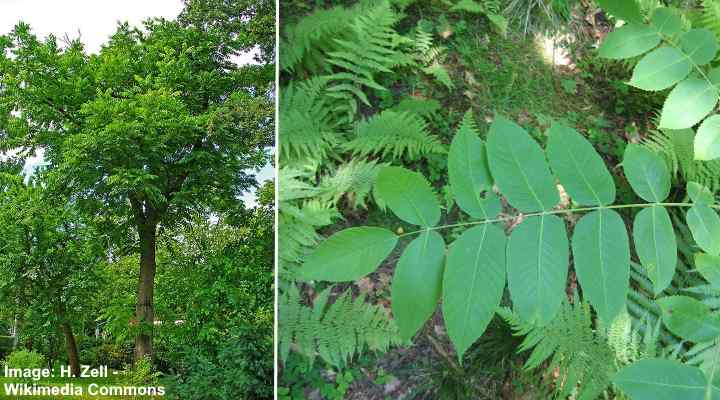
Butternut (white) walnut tree and leaves
Butternut or white walnut trees have smooth gray bark, grow up to 66 ft. (20 m), and produce delicious nuts. Butternut trees resemble black walnut trees, only that they are smaller with smoother bark. White walnuts grow in full sun and thrive in zones 3 to 7.
Butternut trees have a few distinguishing features that set them apart from other walnut species. For instance, the fruit of butternut trees is oval-shaped instead of round. Additionally, their leaves typically have a lower number of leaflets compared to other walnut varieties. Moreover, white walnut trees demonstrate less tolerance to heat when compared to black walnut trees.
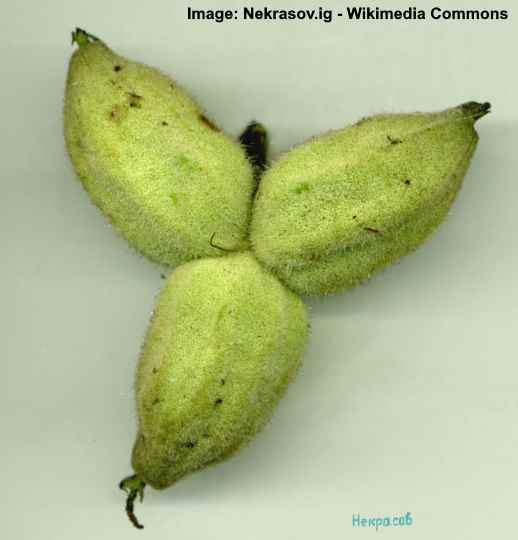
The fruits of butternut (white) walnut tree have oval shape and green husk
Butternut walnuts offer a distinct buttery taste, unlike the earthy flavor of black walnuts.
White walnut trees also emit toxic chemicals into the ground. However, this is not as strong as black walnut and doesn’t affect surrounding plants as much.
Walnut tree bark: Butternut tree bark is gray and smooth when the tree is young and only becomes rough and fissured when the walnut tree is mature. The furrows on the bark may create a distinctive diamond-shaped or interlacing pattern, particularly on older trees.
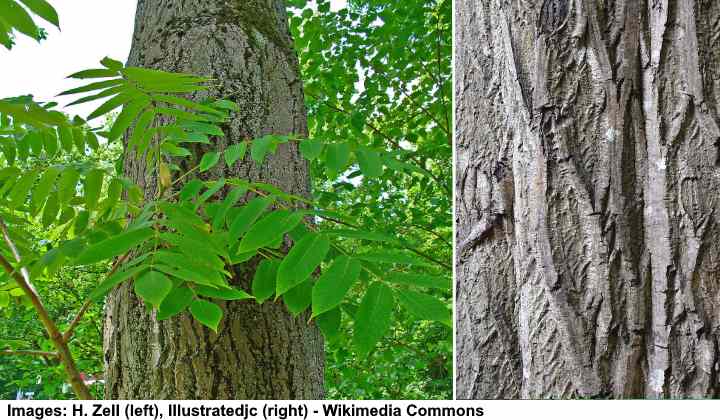
Butternut (white) walnut bark
Walnut tree leaves: Butternut tree leaves contain between 11 and 23 leaflets which have an oblong, lanceolate shape up to 5” (12 cm) long. The leaflets have toothed-edges, and they come to a distinct tip. The leaf stems always have a single large tip or terminal leaf.
How to Identify the Walnut Tree
The white walnut tree (Juglans cinerea), can be identified by its compound leaves with 11 to 23 lance-shaped leaflets, light gray or pale brown bark, and oblong nuts with a rough green husk. Growing up to 66 feet (20 meters) in height, it is native to eastern North America and thrives in well-drained soil.
English Walnut (Juglans regia)
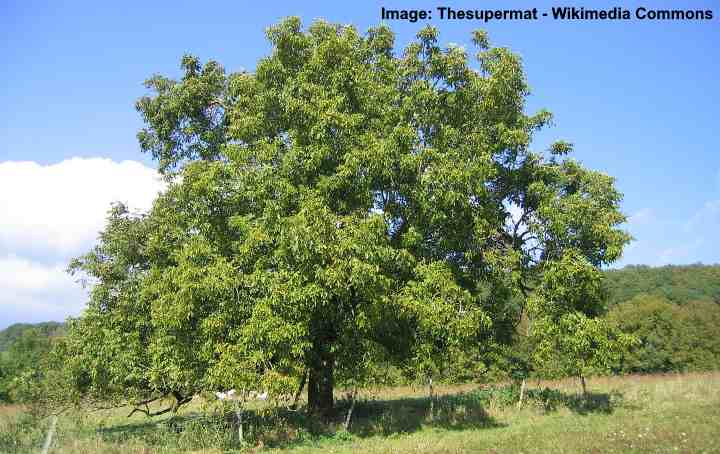
English walnut (Juglans regia) tree
The English walnut tree has smooth olive-colored bark when young that becomes deeply fissured and gray as it matures. English walnuts grow to around 65 ft. (20 m) with a crown of pinnate leaves just as wide. English walnut trees are the primary source of walnuts sold in stores today.
The English walnut tree is also called the Persian walnut, Madeira walnut, and Carpathian walnut. These common names for the walnut tree relate to the tree’s native habitat in southern Europe. Common walnut trees thrive in full sun and grow in zones 5 – 9.
Like black walnut trees, English walnuts produce round drupes and tasty nuts.
English walnuts (Juglans regia) look like green tennis balls when they are on the tree. But after falling to the ground, their rough green husks turn from green color to a very dark brown (almost black) color.
The taste of English walnuts is described as mild and pleasant. You can also eat the whole nut, and pickled walnuts are a delicacy in some parts of Europe.
Walnut tree bark: English walnut trees have deep gray to brown bark with deep, rounded fissures.
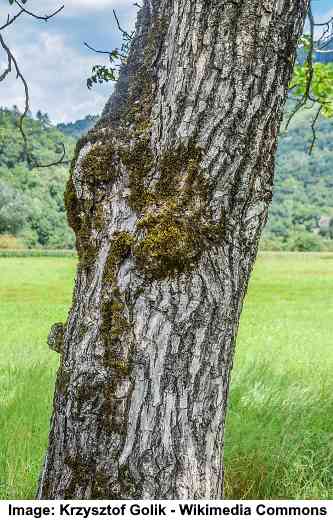
English walnut bark
Walnut tree leaves: The pinnate leaves of English walnut trees consist of 5 to 9 leaflets, always featuring a single blade at the tip. Each individual leaflet measures 4 to 7 inches (10 – 18 cm) in length. In contrast to butternut and black walnuts, English walnut trees have a lower leaflet count.
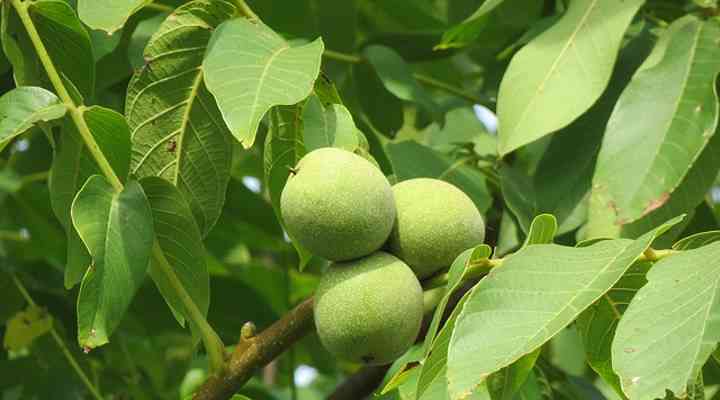
English walnuts look like smooth green balls on the tree
How to Identify the Walnut Tree
To identify the English walnut tree (Juglans regia), look for the following distinguishing features: compound leaves with 5 to 9 oval-shaped leaflets, a dark green color during the growing season, and a yellow-green hue in the fall. The bark can vary in color from gray to brown. English walnut trees grow to medium to large sizes, reaching heights of 65 feet (20 meters), with a rounded or spreading canopy. The nuts are round or oval with a thin, papery husk that splits open when mature. The English walnut tree is commonly cultivated and favored for its high-quality, mild-flavored nuts.
California Black Walnut (Juglans californica)
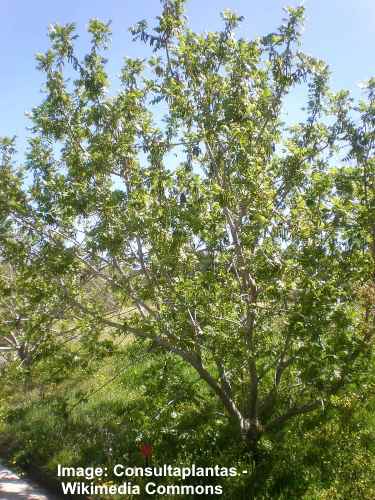
California black walnut tree
The California black walnut tree is an uncommonly large, multi-stemmed shrub or small tree with a single trunk. California walnuts grow to between 20 and 50 ft. (6 – 15 m) tall and thrive in warm climates and full sun. These small walnut trees grow in zones 7 – 10.
Walnut tree bark: California black walnut trees have thick bark that is a dark gray color. The bark is recognizable with its deep furrows running up and down the trunk.
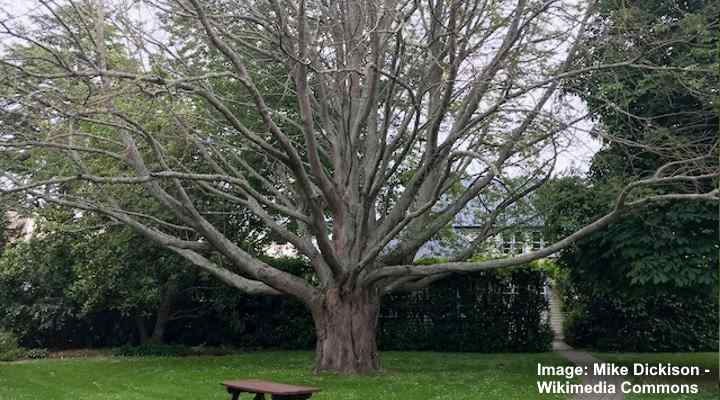
California black walnut bark
Walnut tree leaves: California black walnut tree leaves are smooth with slight serration along the margins. Between 11 and 19 elongated leaflets make up the pinnate leaves.
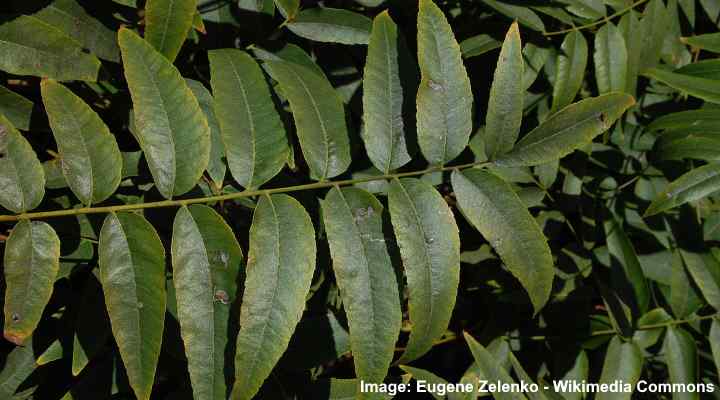
California black walnut leaves
How to Identify the Walnut Tree
To identify the California black walnut tree (Juglans californica), observe the following distinctive characteristics: it has compound leaves with 11 to 19 leaflets, which are lance-shaped with serrated edges. The leaves are typically a vibrant green color and turn yellow in the fall. The bark of the tree is dark brown and deeply furrowed, providing a rough texture. California black walnut trees are medium-sized, reaching heights of 20 to 50 feet (6 to 15 meters), with a rounded crown. The tree produces round or oblong nuts with a thick, hard shell that is difficult to crack. These trees are native to California and are well-suited to the region’s climate and soil conditions.
Northern California Black Walnut (Juglans hindsii)

Northern California black walnut tree and leaves
The Northern California walnut tree has a single trunk, and the tree grows up to 60 ft. (18 m) tall. Also called Hinds’ black walnut or claro walnut, the tree is mostly used in the lumber industry. These black walnut trees grow in dry, sunny climates in zones 8 and 9.
Walnut tree bark: Northern California black walnuts have dark gray bark with moderate fissuring on the trunk.
Walnut tree leaves: The ‘Hinds’ black walnut’s leaves are about 12” (30 cm) long. The blades are made up of 13 – 21 leaflets up to 5″ (12 cm) long. There are some small tufts of hair on the leaves.
Arizona Black Walnut (Juglans major)
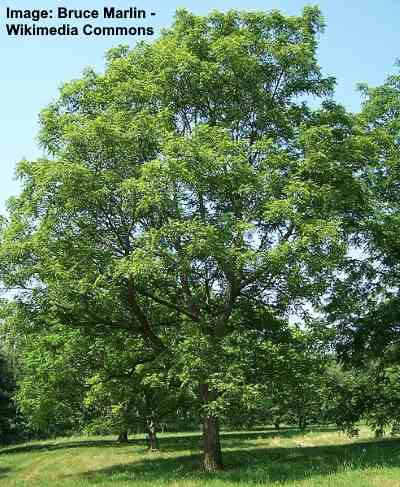
Arizona black walnut tree
Arizona black walnut is a small walnut tree that grows up to 50 ft. (15 m) tall. The short trunk supports a vast, broad, spreading crown that’s up to 65 ft. (20 m) wide. Arizona walnut trees produce small edible nuts.
Walnut tree bark: Arizona black walnuts have gray-brown bark with deep furrows and flat-topped ridges.
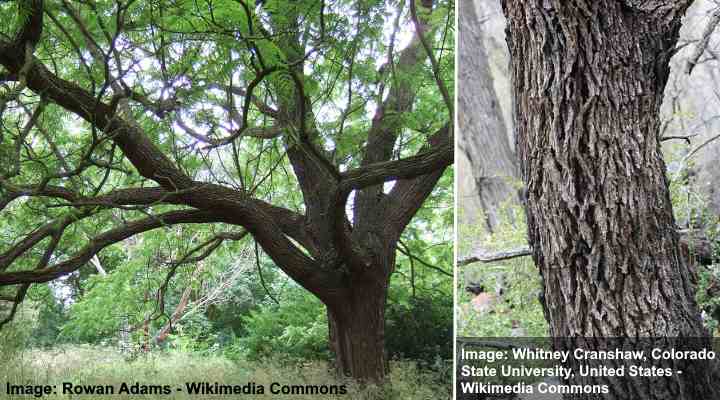
Arizona black walnut bark
Walnut tree leaves: Like all species of walnuts, Arizona walnut trees have pinnately compound leaves. Each leaf contains between 9 and 15 leaflets that are pointed and oblong.
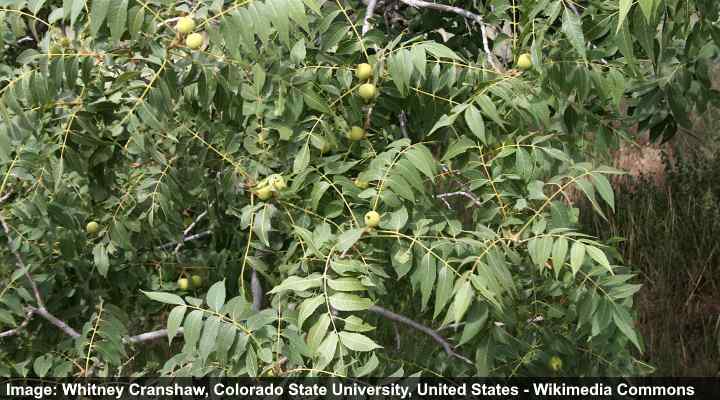
Arizona black walnut tree produces fruits that look like green balls. The leaves of the tree have green color.
Andean Walnut (Juglans neotropica)
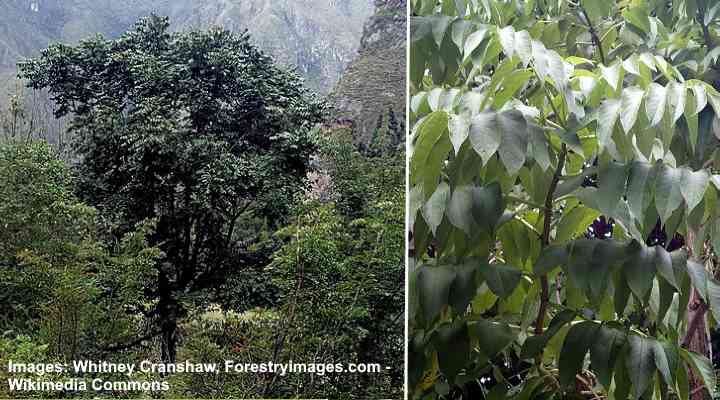
Andean walnut tree and leaves
Andean walnut trees are slow-growing trees in the genus Juglans. Andean walnuts grow up to 131 ft. (40 m) tall and are found in the mountains of Peru, Columbia, and Ecuador. These tropical walnut trees are prized for their high-quality red-colored timber. Other names for this walnut species are Columbian walnut, Ecuadorian walnut, and Cedro negro.
Walnut tree bark: The Andean walnut tree has a reddish-brown bark that has deep, long grooves.
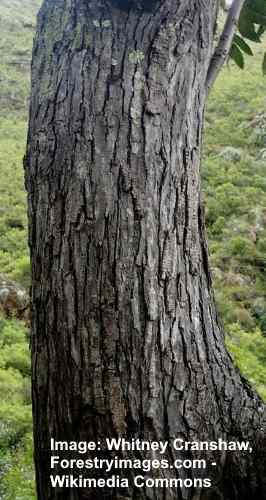
Andean walnut bark
Walnut tree leaves: The tropical walnut has long leaves up to 15” (40 cm). The walnut leaves comprise of pointed oval leaflets.
Japanese Walnut (Juglans ailantifolia)
Japanese walnut trees are similar to butternut trees due to their leaf shape and buttery nuts. These Asian walnut trees grow up to 66 ft. (20 m) and have light gray bark. An unusual feature of these walnuts is that the fruits are heart-shaped rather than round or oval.

Japanese walnut fruit and nut
Walnut tree bark: Japanese walnuts have light gray bark with grooves that form a network pattern.
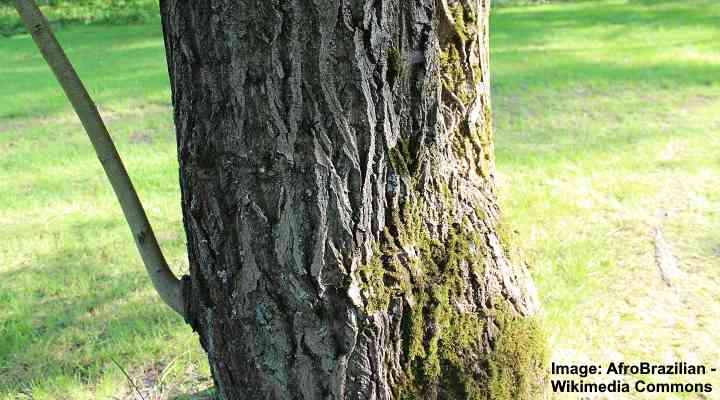
Japanese walnut bark
Walnut tree leaves: Japanese walnut trees have leaves that reach a size of 2 ft. (60 cm), featuring between 11 and 17 large leaflets. Each leaflet can measure up to 6″ (16 cm) in length.
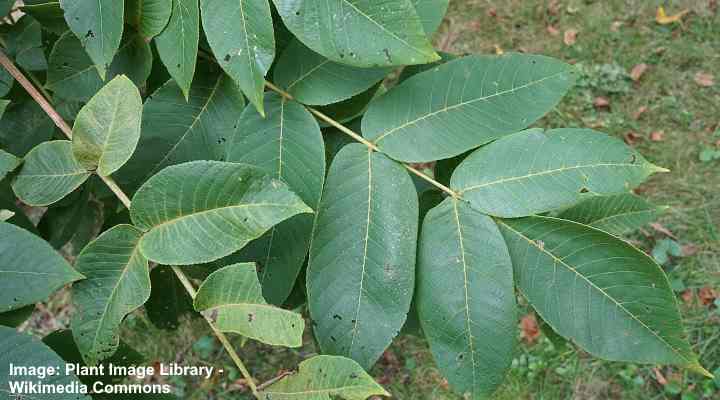
Japanese walnut leaves
Little Walnut (Juglans microcarpa)
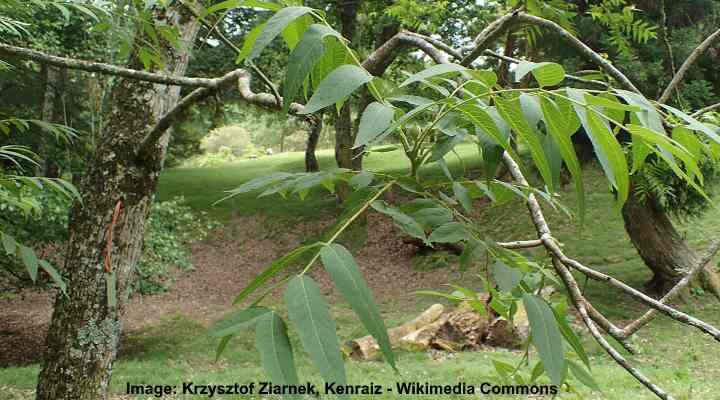
Little walnut leaves and bark
Also called the Texas black walnut, this small walnut species is a large tree-like shrub. The Texas walnut tree grows to between 10 and 30 ft. (3 – 9 m) tall. The sun-loving walnut shrub grows in zones 7 – 9. However, its timber and fruit are insignificant and of little use.
Walnut tree bark: The little walnut tree has gray to dark brown bark with deep furrows in indistinct patterns.
Walnut tree leaves: The little Texas walnut tree’s leaves have between 7 and 25 small leaflets with smooth or slightly serrated margins.
Manchurian Walnut (Juglans mandshurica)
The Manchurian walnut tree is native to East Asia and is one of the cold hardiest walnut trees. The fast-growing tall walnut trees are sometimes grown as ornamental trees because their nuts are small and difficult to extract. Manchurian walnuts are cold hardy in zones 2 – 8 and can withstand temperatures as low as -49°F (-45°C).
Walnut tree bark: The Manchurian walnut tree has grayish-brown bark with fissuring common to most walnut tree species.
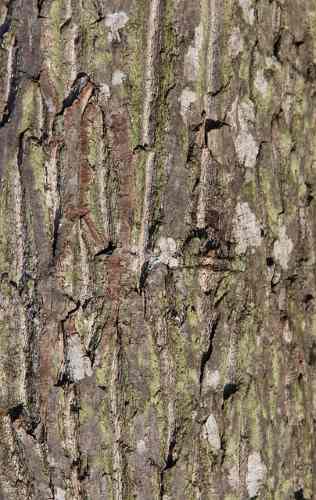
Manchurian walnut bark
Walnut tree leaves: The pinnately compound leaves of the Manchurian walnut tree have 3 to 9 pairs of leaflets with a single terminal leaf.
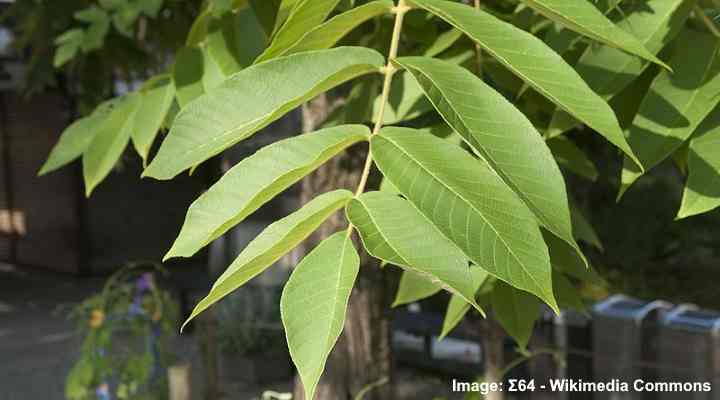
Manchurian walnut (Juglans mandshurica ‘sachalinensis’) leaves
Related articles:
- Elm Trees: Identification, Bark and Leaves
- Types of Oak Trees with Their Bark and Leaves
- Types of Willow Trees: Weeping, Shrubs, Dwarf and More
